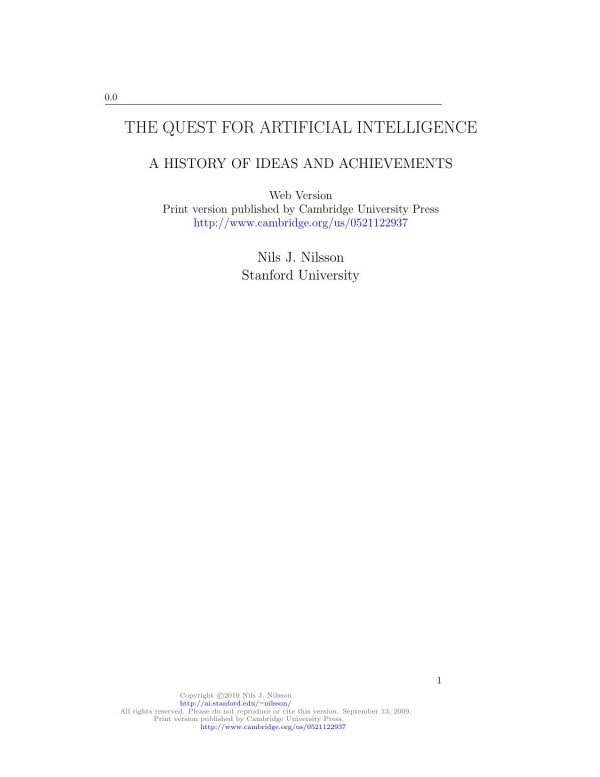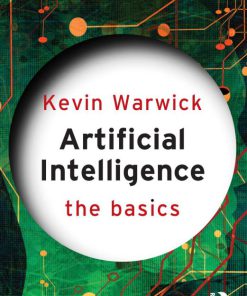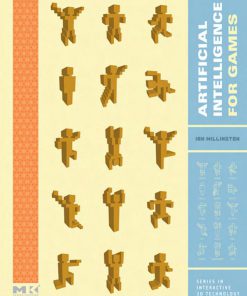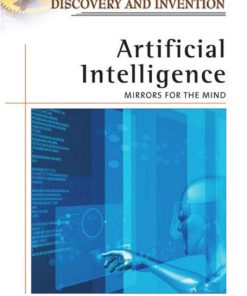The Quest for Artificial Intelligence 1st edition by Nils Nilsson 1139635530 9781139635530
$50.00 Original price was: $50.00.$25.00Current price is: $25.00.
Authors:Nils Nilsson , Author sort:Nilsson, Nils
The Quest for Artificial Intelligence 1st edition by Nils J. Nilsson – Ebook PDF Instant Download/DeliveryISBN: 1139635530, 9781139635530
Full download The Quest for Artificial Intelligence 1st edition after payment.
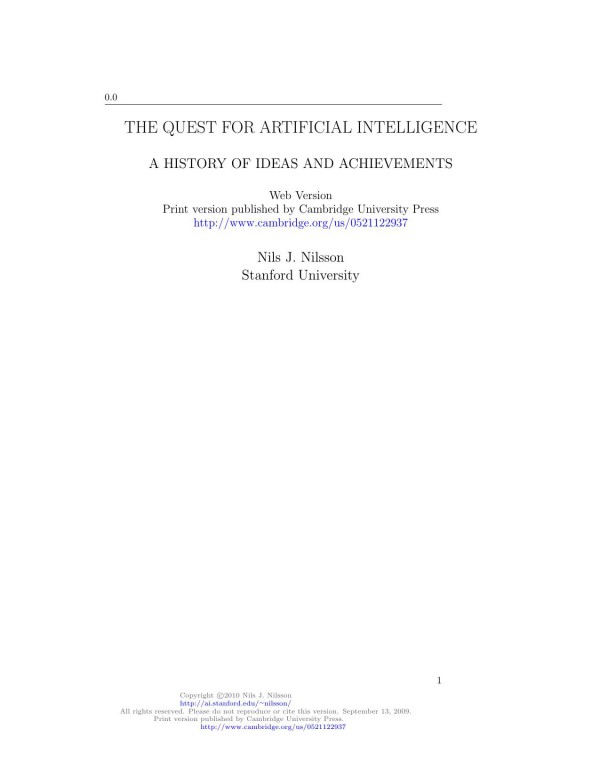
Product details:
ISBN-10 : 1139635530
ISBN-13 : 9781139635530
Author : Nils J. Nilsson
Artificial intelligence (AI) is a field within computer science that is attempting to build enhanced intelligence into computer systems. This book traces the history of the subject, from the early dreams of eighteenth-century (and earlier) pioneers to the more successful work of today’s AI engineers. AI is becoming more and more a part of everyone’s life. The technology is already embedded in face-recognizing cameras, speech-recognition software, Internet search engines, and health-care robots, among other applications. The book’s many diagrams and easy-to-understand descriptions of AI programs will help the casual reader gain an understanding of how these and other AI systems actually work. Its thorough (but unobtrusive) end-of-chapter notes containing citations to important source materials will be of great use to AI scholars and researchers. This book promises to be the definitive history of a field that has captivated the imaginations of scientists, philosophers, and writers for centuries.
The Quest for Artificial Intelligence 1st Table of contents:
Part I: Beginnings
1. Dreams and Dreamers
2. Clues
2.1. From Philosophy and Logic
2.2. From Life Itself
2.3. From Engineering
Part II: Early Explorations: 1950s and 1960s
3. Gatherings
3.1. Session on Learning Machines
3.2. The Dartmouth Summer Project
3.3. Mechanization of Thought Processes
4. Pattern Recognition
4.1. Character Recognition
4.2. Neural Networks
4.3. Statistical Methods
4.4. Applications of Pattern Recognition to Aerial Reconnaissance
5. Early Heuristic Programs
5.1. The Logic Theorist and Heuristic Search
5.2. Proving Theorems in Geometry
5.3. The General Problem Solver
5.4. Game-Playing Programs
6. Semantic Representations
6.1. Solving Geometric Analogy Problems
6.2. Storing Information and Answering Questions
6.3. Semantic Networks
7. Natural Language Processing
7.1. Linguistic Levels
7.2. Machine Translation
7.3. Question Answering
8. 1960s’ Infrastructure
8.1. Programming Languages
8.2. Early AI Laboratories
8.3. Research Support
8.4. All Dressed Up and Places to Go
Part III: Efflorescence: Mid-1960s to Mid-1970s
9. Computer Vision
9.1. Hints from Biology
9.2. Recognizing Faces
9.3. Computer Vision of Three-Dimensional Solid Objects
10. “Hand–Eye” Research
10.1. At MIT
10.2. At Stanford
10.3. In Japan
10.4. Edinburgh’s “Freddy”
11. Knowledge Representation and Reasoning
11.1. Deductions in Symbolic Logic
11.2. The Situation Calculus
11.3. Logic Programming
11.4. Semantic Networks
11.5. Scripts and Frames
12. Mobile Robots
12.1. Shakey, the SRI Robot
12.2. The Stanford Cart
13. Progress in Natural Language Processing
13.1. Machine Translation
13.2. Understanding
14. Game Playing
15. The Dendral Project
16. Conferences, Books, and Funding
Part IV: Applications and Specializations: 1970s to Early 1980s
17. Speech Recognition and Understanding Systems
17.1. Speech Processing
17.2. The Speech Understanding Study Group
17.3. The DARPA Speech Understanding Research Program
17.4. Subsequent Work in Speech Recognition
18. Consulting Systems
18.1. The SRI Computer-Based Consultant
18.2. Expert Systems
19. Understanding Queries and Signals
19.1. The Setting
19.2. Natural Language Access to Computer Systems
19.3. HASP/SIAP
20. Progress in Computer Vision
20.1. Beyond Line-Finding
20.2. Finding Objects in Scenes
20.3. DARPA’s Image Understanding Program
21. Boomtimes
Part V: “New-Generation” Projects
22. The Japanese Create a Stir
22.1. The Fifth-Generation Computer Systems Project
22.2. Some Impacts of the Japanese Project
23. Darpa’s Strategic Computing Program
23.1. The Strategic Computing Plan
23.2. Major Projects
23.3. AI Technology Base
23.4. Assessment
Part VI: Entr’acte
24. Speed Bumps
24.1. Opinions from Various Onlookers
24.2. Problems of Scale
24.3. Acknowledged Shortcomings
24.4. The “AI Winter”
25. Controversies and Alternative Paradigms
25.1. About Logic
25.2. Uncertainty
25.3. “Kludginess”
25.4. About Behavior
25.5. Brain-Style Computation
25.6. Simulating Evolution
25.7. Scaling Back AI’s Goals
Part VII: The Growing Armamentarium: From the 1980s Onward
26. Reasoning and Representation
26.1. Nonmonotonic or Defeasible Reasoning
26.2. Qualitative Reasoning
26.3. Semantic Networks
27. Other Approaches to Reasoning and Representation
27.1. Solving Constraint Satisfaction Problems
27.2. Solving Problems Using Propositional Logic
27.3. Representing Text as Vectors
27.4. Latent Semantic Analysis
28. Bayesian Networks
28.1. Representing Probabilities in Networks
28.2. Automatic Construction of Bayesian Networks
28.3. Probabilistic Relational Models
28.4. Temporal Bayesian Networks
29. Machine Learning
29.1. Memory-Based Learning
29.2. Case-Based Reasoning
29.3. Decision Trees
29.4. Neural Networks
29.5. Unsupervised Learning
29.6. Reinforcement Learning
29.7. Enhancements
30. Natural Languages and Natural Scenes
30.1. Natural Language Processing
30.2. Computer Vision
31. Intelligent System Architectures
31.1. Computational Architectures
31.2. Cognitive Architectures
Part VIII: Modern AI: Today and Tomorrow
32. Extraordinary Achievements
32.1. Games
32.2. Robot Systems
33. Ubiquitous Artificial Intelligence
33.1. AI at Home
33.2. Advanced Driver Assistance Systems
33.3. Route Finding in Maps
33.4. You Might Also Like . . .
33.5. Computer Games
34. Smart Tools
34.1. In Medicine
34.2. For Scheduling
34.3. For Automated Trading
34.4. In Business Practices
34.5. In Translating Languages
34.6. For Automating Invention
34.7. For Recognizing Faces
35. The Quest Continues
35.1. In the Labs
35.2. Toward Human-Level Artificial Intelligence
35.3. Summing Up
People also search for The Quest for Artificial Intelligence 1st:
the quest for artificial general intelligence
what knowledge is required for artificial intelligence
questions about artificial intelligence
what is artificial in artificial intelligence
artificial intelligence eligibility

